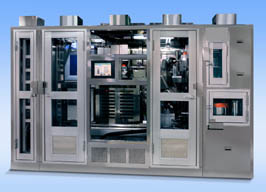Tokyo, June 12, 2008 — Kawasaki Heavy Industries, Ltd. announced today that it has started manufacturing and selling automated cell culture systems jointly with Kawasaki Plant Systems, Ltd. The cell culture systems will become available on the market in July for use in drug discovery and development.
Kawasaki revealed the first prototype designed for the tissue engineering industry in December 2006 and has conducted evaluation tests at Shinshu University Hospital’s Advanced Medical Center. Kawasaki incorporated the test findings into the development of this new cell culture system. Work on the system was conducted under a development project commissioned by the Japan Science and Technology Agency (JST).
This system employs fully-automated, clean robotic operations to culture adhesion cells, which are needed for drug discovery and development. Since it can easily culture multiple cell lines, it can be used for cell-based high content screening.
In preparation for the launch of its cell culture system business, Kawasaki verified the system’s performance through a series of tests conducted at its facility. The system has also been highly evaluated by the National Institute of Advanced Industrial Science and Technology for being stable enough to culture high quality cells as well as for being user-friendly.
Kawasaki’s cell culture system includes the following features:
(1) Fully automated cell culture procedures
The system automatically performs a series of procedures such as medium replacement, sub-culturing, cell retrieval and observation which have conventionally been performed manually. It employs centrifugal separation for sub-culturing and performs tapping and pipetting during the cell detachment procedure.
(2) Capable of handling various types of cells
In addition to being equipped with general cell culture parameters, the system allows users to set parameters for other types of cells used for high-content screening. Users can change a number of parameters such as detachment processing time, amount of solution, and pipetting frequency during sub-culturing. Coating dishes can also be used for culturing special types of cells.
(3) Image data for monitoring cultured cells
The system is equipped with an image processing device that displays and automatically records images of cultured cells to enable better monitoring and facilitate timely cell retrieval and sub-culturing.
(4) Culture task scheduling
TThe system enables users to easily schedule daily culture operations. Operators can schedule cell culture operations to finish at a specific time to assure a reliable supply of cells.
(5) Ensured stability and consistency of cell quality
Automated cell culturing ensures stability and consistency in performance and quality.
(6) Contamination free
The system provides a class 100 (FS209E) clean environment with automated robotic operations to prevent contamination. Use of sterilized disposable pipette tips as well as automatic alcohol decontamination ensures that there is no cross contamination.
(7) Compact design
Consisting of an industrial robot for clean rooms, a culture system, an incubator, and an image processing device, the entire system boasts a compact design measuring 3 meters in width, 1 meter in depth and 2 meters in height. Unlike conventional systems that cannot be installed against a wall, this system can easily fit into any corner of a laboratory since it can be installed with two sides facing against the walls.
|






